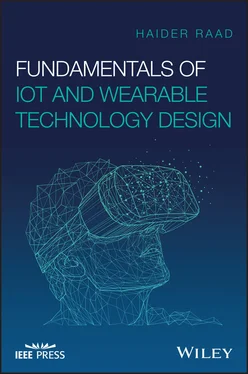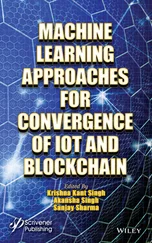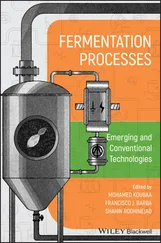1 Cover
2 Title Page
3 Copyright Page
4 About the Author
5 Preface
6 Acknowledgment
7 1 Introduction and Historical Background1.1 Introduction 1.2 Conclusion Problems Interview Questions Further Reading
8 2 Applications2.1 Introduction 2.2 IoT and Wearable Technology Enabled Applications 2.3 Smart Cities 2.4 Internet of Vehicles (IoV) 2.5 Conclusion Problems Interview Questions Further Reading
9 3 Architectures3.1 Introduction 3.2 IoT and Wearable Technology Architectures 3.3 Conclusion Problems Technical Interview Questions Further Reading
10 4 Hardware4.1 Introduction 4.2 Hardware Components Inside IoT and Wearable Devices 4.3 Conclusion Problems Technical Interview Questions Further Reading
11 5 Communication Protocols and Technologies5.1 Introduction 5.2 Types of Networks 5.3 Network Topologies 5.4 Protocols 5.5 Conclusion Problems Technical Interview Questions Further Reading
12 6 Product Development and Design Considerations6.1 Introduction 6.2 Product Development Process 6.3 IoT and Wearable Product Requirements 6.4 Design Considerations 6.5 Conclusion Problems Interview Questions Further Reading
13 7 Cloud and Edge: Architectures, Topologies, and Platforms7.1 Introduction 7.2 Cloud 7.3 Edge and Fog 7.4 Platforms 7.5 Data Analytics and Machine Learning 7.6 Conclusion Problems Technical Interview Questions References Further Reading
14 8 Security8.1 Introduction 8.2 Security Goals 8.3 Threats and Attacks 8.4 Security Consideration 8.5 Conclusion Problems Technical Interview Questions Further Reading
15 9 Concerns, Risks, and Regulations9.1 Introduction 9.2 Privacy Concerns 9.3 Psychological and Social Concerns 9.4 Safety Concerns 9.5 Health Concerns 9.6 Regulations Further Reading
16 10 Detailed Product Design and Development: From Idea to Finished Product 10.1 Introduction 10.2 Product I (IoT): Vineyard Monitor 10.3 Product II (Wearable): Fall Detection Device 10.4 Conclusion References Further Reading
17 Index
18 Solution ManualChapter 1 Homework Problems: Chapter 2 Homework Problems: Chapter 3 Homework Problems: Chapter 4 Homework Problems Chapter 5 Homework Problems Chapter 6 Homework Problems Chapter 7 Homework Problems: Chapter 8 Homework Problems
19 End User License Agreement
1 Chapter 1 Figure 1.1 Characteristics of the Internet of Things. Figure 1.2 Forms of wearable technology. Figure 1.3 Characteristics of wearable technology. Figure 1.4 A summary of the main differences between M2M, IoT, and Wearable ... Figure 1.5 The pulsar calculator LED watch released in 1975. Figure 1.6 Steve Mann wearing one of his wireless wearable webcam. Figure 1.7 The Apple watch. Figure 1.8 Fitbit Surge smart watch fitness tracker. Figure 1.9 Explorer edition of Google Glass©. Figure 1.10 Infographic photo of the Google Smart Lens©.
2 Chapter 2 Figure 2.1 Areas of the smart home concept. Figure 2.2 Functional areas of smart cities. Figure 2.3 The major areas of IoV.
3 Chapter 3Figure 3.1 A comparison between Cloud, Fog, and Mist computing.Figure 3.2 The OSI reference model.Figure 3.3 Basic three‐layer IoT architecture.Figure 3.4 IoT reference model reported by the IoT World Forum.Figure 3.5 Simplified IoT architecture.Figure 3.6 A basic architecture for wearable devices.
4 Chapter 4Figure 4.1 Anatomy of a generic smart connected device.Figure 4.2 Sensor and actuator signal flow in a system.Figure 4.3 The arm MPS2 + FPGA prototyping board. The platform offers a larg...Figure 4.4 Printed monopole antenna intended for integration within flexible...Figure 4.5 Omni directional radiation pattern (left), and semi‐directional (...
5 Chapter 5Figure 5.1 Types of computer networks.Figure 5.2 An example of a local area network with a diversity of devices.Figure 5.3 Common types of network topologies.Figure 5.4 Typical TCP/IP stack (left), IoT/wearable devices protocol stack ...Figure 5.5 An example of an end‐to‐end IoT/wearable device connectivity.
6 Chapter 6Figure 6.1 A general modern electronic product development process diagram....Figure 6.2 A link budget elaboration between a transmitter and a receiver.
7 Chapter 7Figure 7.1 Latency comparison between edge and cloud.
8 Chapter 9Figure 9.1 Omni‐directional radiation pattern (left), and semi‐directional (...
9 Chapter 10Figure 10.1 Vineyard monitor system block diagram.Figure 10.2 Proant 868/915 antenna.Figure 10.3 Sample schematic from DS18B20 datasheet.Figure 10.4 Breadboarding example showing DS18B20 connections.Figure 10.5 Initial working but untidy attempt at breadboarding.Figure 10.6 Tidier breadboard using jumper wires.Figure 10.7 Frizing layout of stripboard.Figure 10.8 Final stripboard prototype.Figure 10.9 Example screenshot of power profiler.Figure 10.10 Example screenshot from Sigfox backend.Figure 10.11 Final board layout, fully routed.Figure 10.12 Product I final schematic.Figure 10.13 Various SMC component sizes.Figure 10.14 Testing soil moisture level and sensor processing.Figure 10.15 Enclosure, side view (a), rear view (b).Figure 10.16 Fall‐detection system block diagram.Figure 10.17 Program execution flowchart.Figure 10.18 Use case UML diagram.Figure 10.19 Hexiwear wearable development board.Figure 10.20 Development boards constituting the Hexiwear platform.Figure 10.21 Hexiwear default and optional components.Figure 10.22 Hexiwear MPUs capabilities and their peripheral connections....Figure 10.23 Hexiwear sensors specification and communication interfaces....Figure 10.24 Hexiwear K64F interfaces with internal docking station sensors....Figure 10.25 (Hexiwear) fall‐detection wearable device.Figure 10.26 Hexiwear docking station.Figure 10.27 Hexiwear beside an apple watch.Figure 10.28 Hexiwear worn.Figure 10.29 KDS stock firmware project import.Figure 10.30 Fall‐detection algorithm flowchart.Figure 10.31 Smartphone app different screens.Figure 10.32 Thingspeak channel configuration.Figure 10.33 Thingspeak channel visualization.Figure 10.34 Battery life estimation using NXP MCU power estimation tool....
1 Cover Page
2 Series Page
3 Title Page
4 Copyright
5 Dedication
6 About the Author
7 Preface
8 Acknowledgment
9 Table of Contents
10 Begin Reading
11 Index
12 Solution Manual
13 WILEY END USER LICENSE AGREEMENT
1 ii
2 iii
3 iv
4 v
5 xv
6 xvii
7 xviii
8 xix
9 xxi
10 1
11 2
12 3
13 4
14 5
15 6
16 7
17 8
18 9
19 10
20 11
21 12
22 13
23 14
24 15
25 16
26 17
27 18
28 19
29 20
30 21
31 22
32 23
33 24
34 25
35 27
36 28
37 29
38 30
39 31
40 32
41 33
42 34
43 35
44 36
45 37
46 38
47 39
48 40
49 41
50 42
51 43
52 44
53 45
54 46
55 47
56 48
57 49
58 50
59 51
60 53
61 54
62 55
63 56
64 57
65 58
66 59
67 60
68 61
69 62
70 63
71 64
72 65
73 66
74 67
75 68
76 69
77 70
78 71
79 72
80 73
81 74
82 75
83 76
84 77
85 78
86 79
87 80
88 81
89 82
90 83
91 84
92 85
93 86
94 87
95 88
96 89
97 90
98 91
99 92
100 93
101 94
102 95
103 96
104 97
105 98
106 99
107 100
108 101
109 102
110 103
111 104
112 105
113 106
Читать дальше












